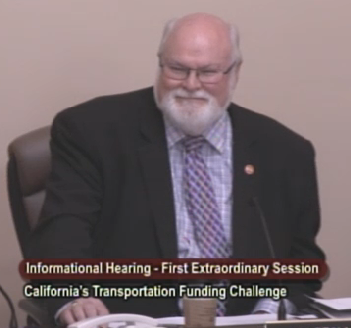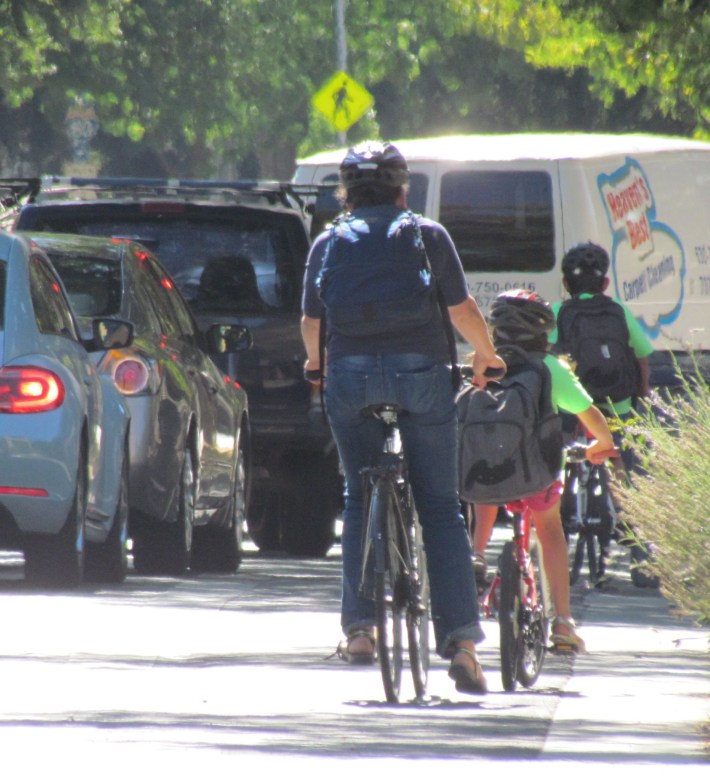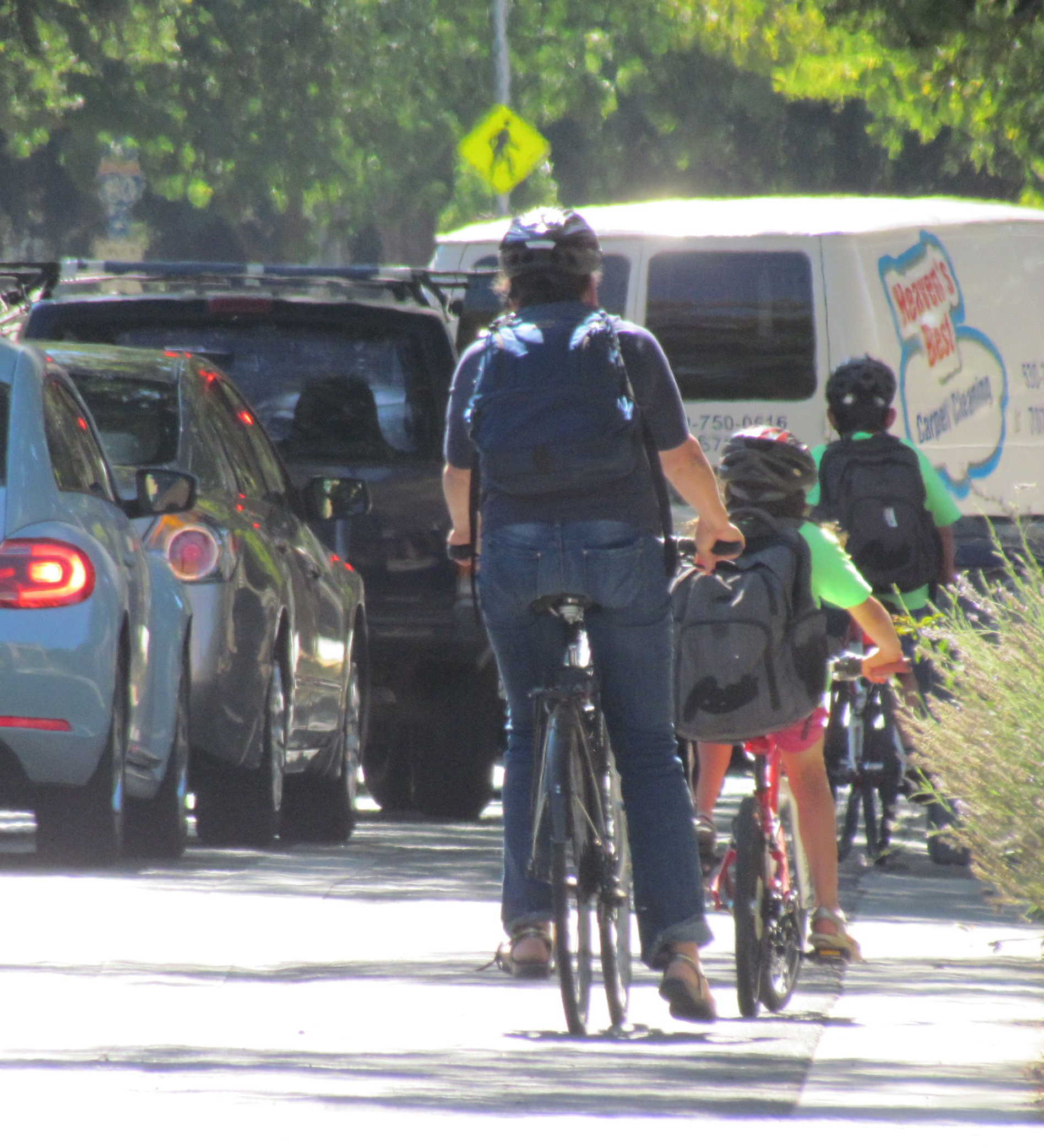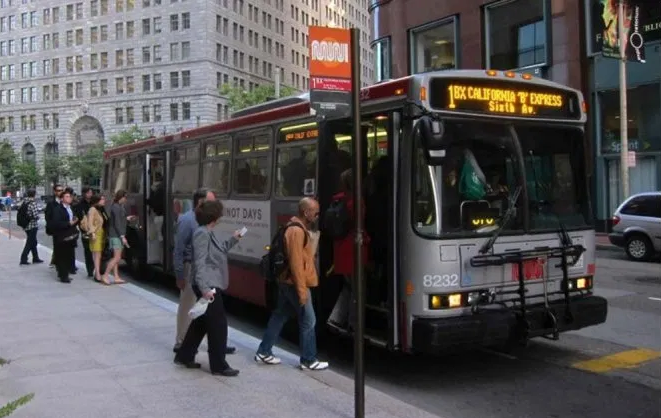New Transportation Funding Plan: A Hot Mess, With Some Active Transp $
4:25 PM PDT on August 25, 2016

After several weeks of rumors, legislative leaders of the Special Session on Transportation and Infrastructure have released their proposal for a funding plan that shows how much compromise it can take to get an agreement.
The bill, S.B. X1-1 and A.B. X1-26, is co-authored by Senator Jim Beall (D-Campbell) and Assemblymember Jim Frazier (D-Oakley), the “two Jims” who head up their separate houses' special session transportation committees. It contains the gas tax increases that Beall believes are necessary to continue funding transportation, and it applies some funding to the freight corridor improvements that Frazier has made his focus.
It also contains provisions that echo Republican demands for both more independence and more oversight of transportation departments, depending on the department.
Because it's part of the Special Session, S.B. X1-1 is not subject to the normal legislative deadlines, so although the regular session officially ends on August 31, the bill can keep chugging along until the end of November. However, legislators' attention will be on their re-election campaigns in the fall, and it's not clear whether calling them back to a post-election session would be fruitful.
It's also not clear what kind of support the proposal will find among the rest of the legislators. Because it requires a two-thirds majority to pass, it will need the votes of all the Democrats and at least some Republicans in both the Assembly and the Senate to move forward. Which may be why it's a very large bill that covers a lot of ground.
Among its $7.4 billion in allocations, it includes an $80 million bump for the oversubscribed and underfunded Active Transportation Program (ATP). This is less than the $100 million proposed in an earlier version of the bill. But the bill also includes a separate allocation of “up to $70 million” for the ATP from “savings achieved through efficiencies implemented” at Caltrans.
What those “savings” and “efficiencies” are, how they are valued, and what would give Caltrans the incentive to make them and report them so they can be allocated to the ATP is unclear.
But if all that funding came through, it could effectively double the size of the ATP. The Senate has also proposed allocating $5 million to the ATP from cap and trade, although again it's not clear to what extend that Greenhouse Gas Reduction Fund (GGRF) expenditure plan is coordinated with this bill. The Assembly, in an earlier proposal for the GGRF, had set aside $100 million for the ATP, but both Assembly leaders and the Governor have hinted that they would be inclined to allocate less from the GGRF overall at this point. How that would affect the final ATP allocation is currently unknown.
Also—sorry, this is really getting into the weeds—it looks like many of the allocations from the Senate bill are indexed to inflation, as are the funding sources, but the ATP allocation is just a flat amount, which could affect the size of the program in the future.
“In theory this sounds really great,” said Bill Sadler, California Senior Policy Manager at Safe Routes to School National Partnership. “We need more money for walking and biking, and this funding package would bolster our Safe Routes to School work and funding for active transportation overall.”
But, he pointed out, it still wouldn't fulfill demand for the ATP. The current round of ATP funding received 470 applications for about $977 million worth of projects over a two-year cycle. The last two grant rounds have received over 600 applications, for over $1 billion, for 3-year funding cycles, and they have been able to fund at the most $358 million of that.

The challenge, if the ATP does get more money, will be to figure out how best to spend it. Would it make sense to continue the current system of two- or three-year funding cycles, with separate pots of funding for statewide, regional, and small urban and rural projects? Would it be better to set aside some money for larger grants to create whole networks of bike and walking infrastructure, rather than the piecemeal approach that most areas have been taking?
And how much should go to planning and programming? Without the capacity to plan for new infrastructure—either as part of a complete bike plan or as individual projects—some jurisdictions are at a disadvantage when it comes to competing for ATP funds. Encouragement and education programs can help increase the use of new facilities, thus helping them fulfill their goals of reducing driving and improving health.
A bill that would have required the ATP to set aside at least ten percent of its funding for planning and programming, A.B. 2796, got stuck in the Senate Appropriations committee and is dead at this point.
Other quirks in SBX1-1 include creating an independent office of Inspector General for transportation and removing the California Transportation Commission (CTC) from oversight by the California State Transportation Agency, (CalSTA). CalSTA was created a few years ago to bring all the transportation departments together under one agency, including the CHP, the DMV, CTC, and Caltrans, among others. The CTC is an appointed body that makes decisions about which transportation projects get funding, from highways to transit to the ATP.
The creation of an Inspector General may be in response to Republican demands for more oversight over Caltrans. But Republicans also decry inefficiencies in transportation spending. It's not clear why creating a new office would more efficient than letting CalSTA do its job. And if more oversight is wanted, why does the CTC need to be independent? Republicans have introduced several bills in the last few years to remove the CTC from CalSTA oversight, the most recent one last year from Senator Sharon Runner (R-Antelope Valley) in the Transportation Special Session.
Both moves could be interpreted as an attempt to weaken CalSTA's authority.
Chanell Fletcher, Associate Director of Climate Plan, says that her organization is concerned about these provisions. “We would like to hear more about what it means,” she said. “Is CalSTA doing its job?” Also, given the work Climate Plan and its partners have done trying to get environmental justice representation on the CTC, they want to know more about how separating the CTC from CalSTA would work. “What does it mean for them to be independent? What would be their relationship with CalSTA?” she asked. “And what would be the relationship between CalSTA and a new Inspector General?”
Other interesting and some alarming items from the huge bill include:
- It would raise the gas tax by 17 cents a gallon and the diesel tax by 30 cents a gallon, and increase the vehicle registration fee by $38, with a higher fee for zero emission vehicles that by definition pay no gas taxes
- It would eliminate several confusing practices related to taxes, repay loans made by the transportation fund, and index taxes and fees to inflation to eliminate the need to raise or adjust them later
- It would allocate a total of $7.4 billion annually to:
- state ($2.9 billion), regional ($534 million), and local jurisdictions ($2.5 billion) for highway and road repair and maintenance
- transit capital projects ($516 million)
- freight corridor improvements ($900 million)
- active transportation ($80 million, with up to $70 million additional from “efficiencies and savings” at Caltrans)
- Advanced Mitigation Program ($30 million)
- It would require Caltrans to update the Highway Design Manual to incorporate “complete streets” design concepts. But Caltrans has already done this, and it hasn't led to the incorporation of the concepts in every project. Why not go full out and require that every state-funded project, with some exemptions—limited-access freeways, say—be a complete streets project?
- It would expand CEQA exemptions to include state roadway projects within an existing right of way
Streetsblog California editor Melanie Curry has been thinking about transportation, and how to improve conditions for bicyclists, ever since commuting to school by bike long before bike lanes were a thing. She was Managing Editor at the East Bay Express, editor of Access Magazine for the University of California Transportation Center, and earned her Masters in City Planning from UC Berkeley.
Read More:
Stay in touch
Sign up for our free newsletter
More from Streetsblog California
Active Transportation Program Calls for Volunteer Evaluators
Apply to be a volunteer ATP application evaluator by May 10.
Study: When Speed Limits Rise on Interstates, So Do Crash Hot Spots on Nearby Roads
Rising interstate speeds don't just make roads deadlier for people who drive on them — and local decision makers need to be prepared.
Eyes on the Street: New Lincoln Park Avenue Bike Lanes
The recently installed 1.25-mile long bikeway spans Lincoln Park Avenue, Flora Avenue, and Sierra Street - it's arguably the first new bike facility of the Measure HLA era
Independent Safety Advocates Beef up the Wiggle
Signs and soft-hit posts installed by advocates make the Wiggle bike route calmer and safer for cyclists and pedestrians
Thursday’s Headlines
LA Metro declares emergency over attacks on bus operators; Some deadly Bay Area streets to see safety fixes; Tax ride-hail to save transit? More




